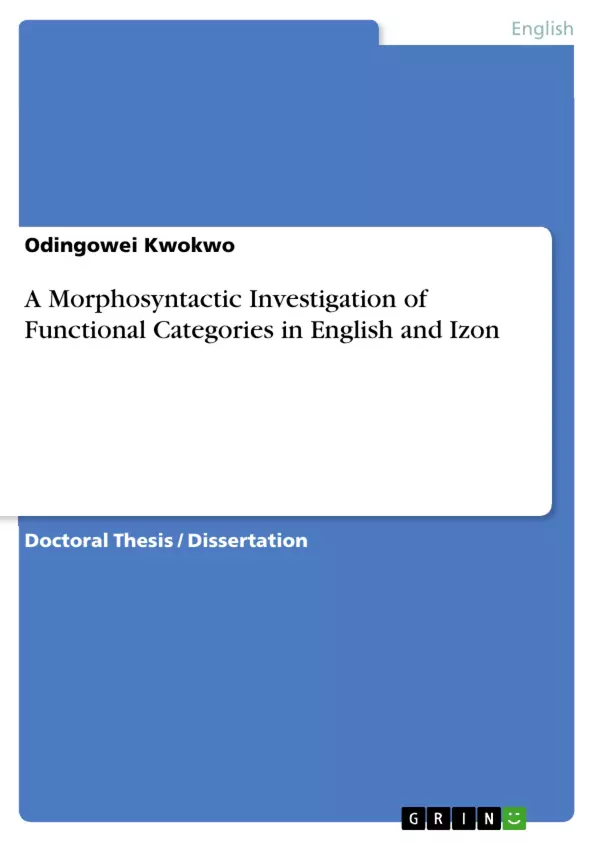Existing studies on Izon language have concentrated on unilingual application of traditional grammar in constructing well-formed sentences, thereby neglecting critical descriptions of the ways morphosyntactic features ensure the derivation of convergent structures.
A contrastive examination of English, (a standard for universal grammar analysis) and Izonn languages can properly characterise these syntactically significant features. This work, therefore, investigates the morphosyntactic features in English and Izon languages with a view to identifying and describing the morphosyntactic features that make the structures of the two languages converge.
The study adopts Chomsky’s Minimalist Program, which emphasises checking of morphological features. The research is based on Standard English and the Kolokuma dialect of Izon, used in education and the media, and is mutually intelligible with other dialects. Data on English were collected from various books on English grammar and those on Izon were collected from native speakers in Kolokuma and Opokuma clans in Bayelsa State where the dialect is spoken, and complemented with the researcher’s native-speaker’s introspective data.
Since the study is competence-based, completely grammatical structures from each language were used for the analysis. Clausal and phrasal syntactic structures of English and Izon languages were comparatively analysed based on the feature-checking processes of the Minimalist Program to identify shared and idiosyncratic features.
Universal features common to both languages include phrases, clauses, syntactic heads and wh-fronting. However, English and Izon opt for different head parameters. Heads in English precede their complements while heads in Izon follow their complements. Although Nominative Case licensing occurs in Spec-head structures in both languages, Accusative Case is licensed in head–complement relationship in English and complement-head structure in Izon. Both English and Izon permit wh-fronting at Spec-CP, but Izon wh-expressions obligatorily co-occur with focus particles ki or ko, which are functional elements that licence wh-elements.
Whereas English constructs relative clauses with overt and interpretable complementizers such as ‘who’, which precede their complement clauses, Izon constructs relative clauses without overt interpretable wh-expressions except an overt amee (that) which follows its complement clause.
Inhaltsverzeichnis (Table of Contents)
- Introduction
- The Minimalist Program
- Principles of the Minimalist Program
- Morphosyntactic Features
- The Derivation Process
- Functional Categories in English
- The Noun Phrase (NP)
- The Verb Phrase (VP)
- The Inflectional Phrase (IP)
- The Complementizer Phrase (CP)
- Functional Categories in Izọn
- The Noun Phrase (NP)
- The Verb Phrase (VP)
- The Inflectional Phrase (IP)
- The Complementizer Phrase (CP)
- Comparative Syntax of English and Izọn
- Head Parameter
- Case Licensing
- Wh-movement
- Determiners and Pronouns
- Verb Agreement
- Discussion and Conclusion
Zielsetzung und Themenschwerpunkte (Objectives and Key Themes)
This thesis investigates the morphosyntactic features of English and Izọn languages to identify and describe the features that lead to convergence in their syntactic structures. It utilizes the Minimalist Program to analyze the two languages, focusing on the checking of morphological features.
- Morphosyntactic features in English and Izọn
- Convergent syntactic structures in the two languages
- The role of the Minimalist Program in analyzing these features
- Universal and language-specific features in English and Izọn
- The interface of functional morphology and syntactic derivations
Zusammenfassung der Kapitel (Chapter Summaries)
The introduction provides an overview of the research topic, outlining the motivations for this study. It discusses existing studies on Izọn language and highlights the need for a contrastive examination of English and Izọn to better understand their morphosyntactic features. The chapter also details the theoretical framework adopted, the Minimalist Program, and its focus on feature-checking.
Chapter 2 presents a detailed discussion of the Minimalist Program, outlining its core principles, the concept of morphosyntactic features, and the derivation process. This chapter serves as a foundation for the analysis of English and Izọn functional categories in subsequent chapters.
Chapter 3 examines the functional categories in English, focusing on the Noun Phrase (NP), Verb Phrase (VP), Inflectional Phrase (IP), and Complementizer Phrase (CP). Each category is analyzed in detail, exploring its structure, the features associated with it, and its role in the derivation process.
Chapter 4 delves into the functional categories in Izọn, mirroring the structure of Chapter 3. It examines the NP, VP, IP, and CP in Izọn, highlighting both similarities and differences with English. This chapter provides a comparative understanding of the two languages' morphosyntactic systems.
Chapter 5 presents a comparative analysis of the syntactic structures of English and Izọn. The chapter focuses on key areas of convergence and divergence, including the head parameter, case licensing, wh-movement, determiners and pronouns, and verb agreement. This comparative analysis highlights both universal and language-specific features of the two languages.
Schlüsselwörter (Keywords)
The central keywords of this thesis include functional categories, universal features, English, Izọn, feature-checking, parametric variation. The study focuses on the analysis of morphosyntactic features and their role in the derivation of syntactic structures. The Minimalist Program serves as the theoretical framework, guiding the investigation of both universal and language-specific features across English and Izọn languages.
- Quote paper
- Dr Odingowei Kwokwo (Author), 2012, A Morphosyntactic Investigation of Functional Categories in English and Izon, Munich, GRIN Verlag, https://www.grin.com/document/314755



